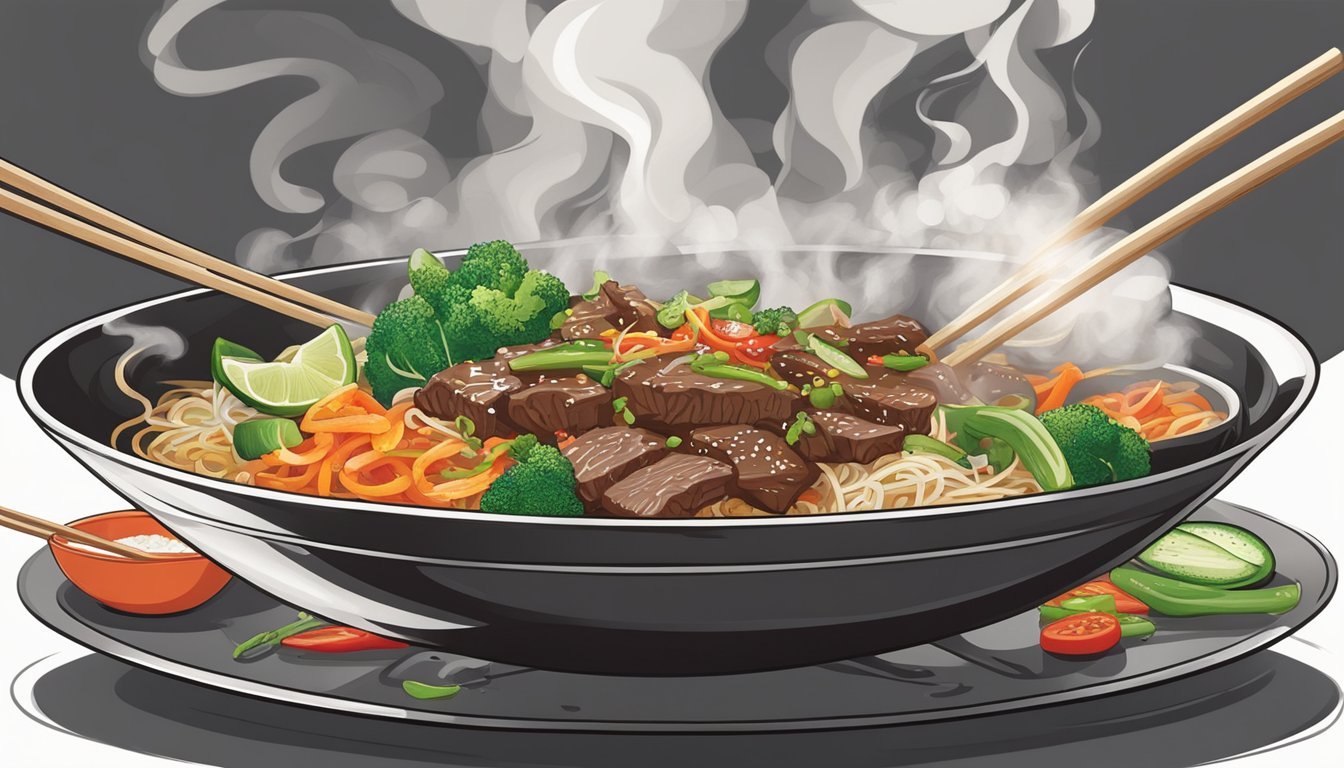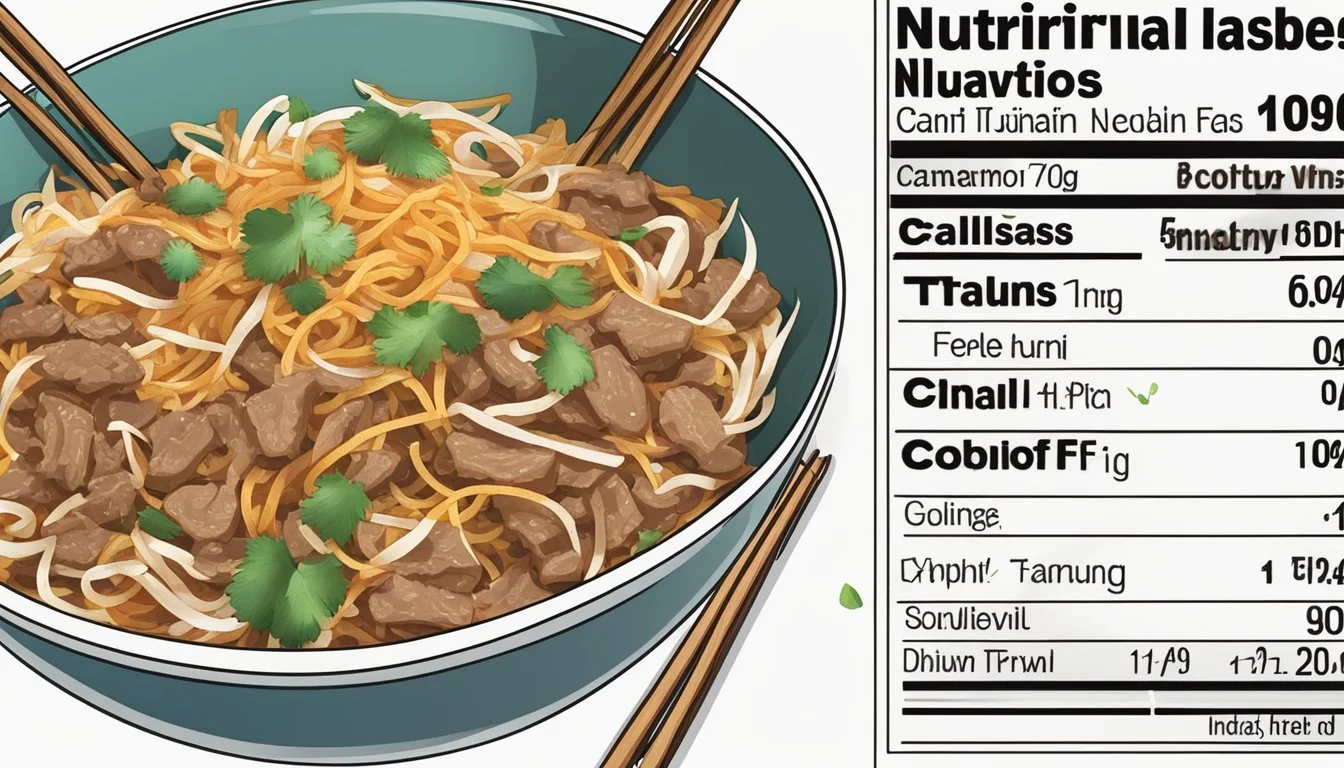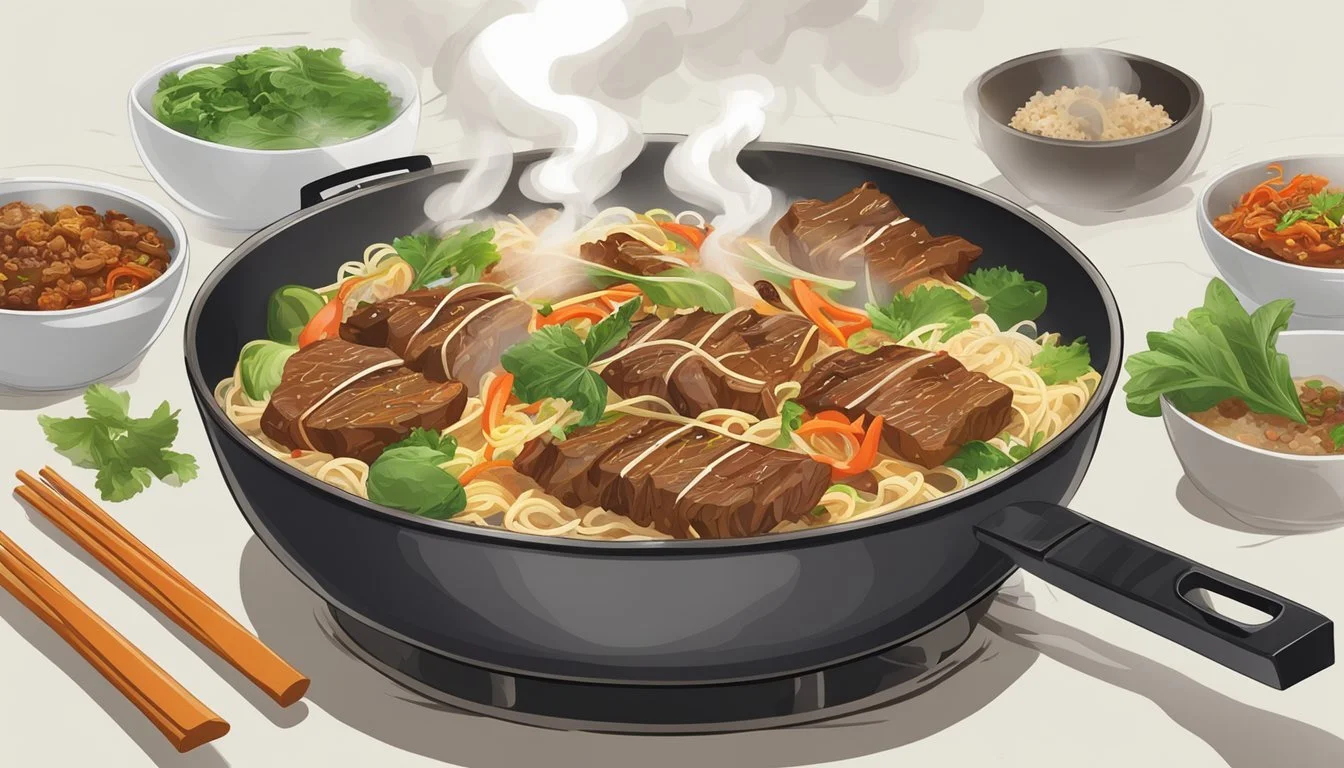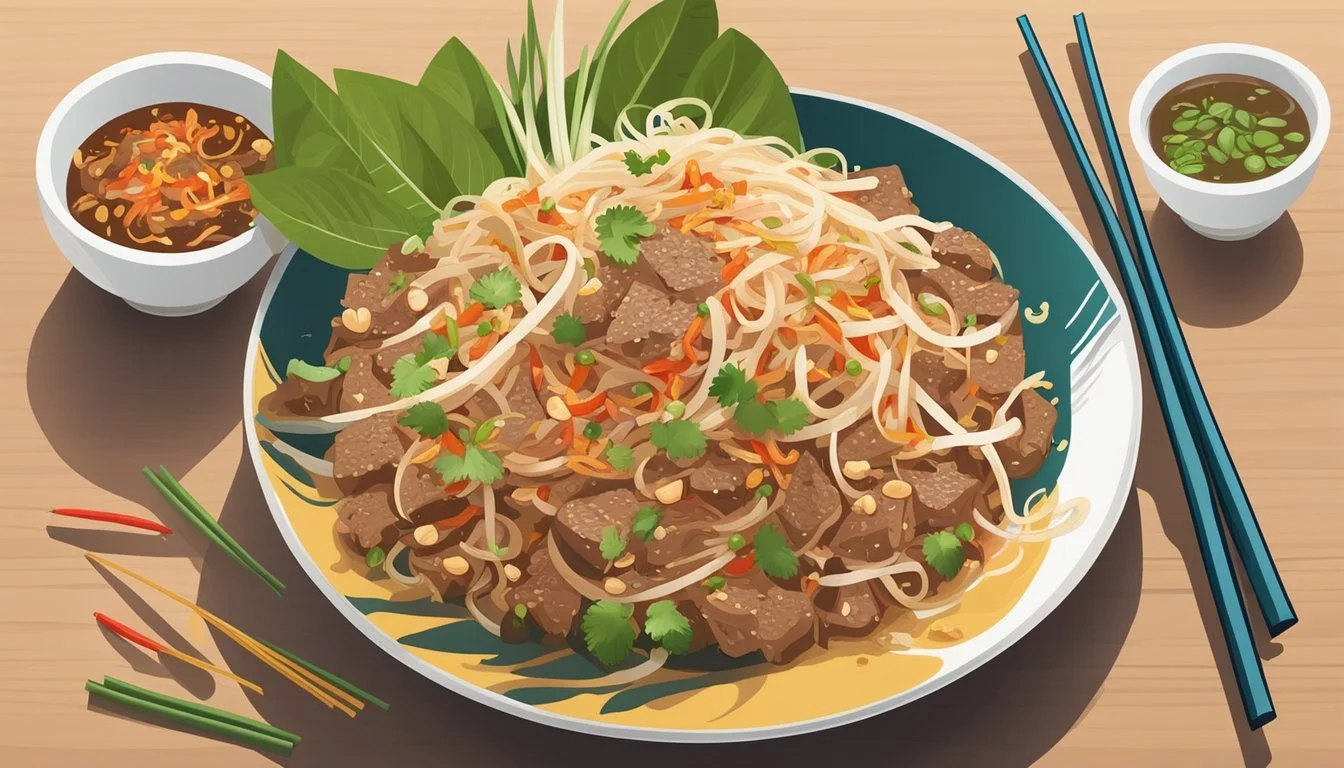How Long Does Beef Pad Thai Last?
Storage Tips and Shelf Life Explained
Beef Pad Thai, a delicious and traditional street food, is a favorite among many for its rich flavors and satisfying textures. When prepared with care, this dish not only delights the taste buds but also offers a glimpse into the culinary traditions of Thailand. However, one may wonder about the best way to store this delightful meal and how long it remains safe to eat.
Properly stored in an airtight container in the refrigerator, Beef Pad Thai can last for up to 3-4 days. It's essential to ensure that the dish is cooled and stored promptly to maintain its freshness and prevent bacterial growth. While the rich and flavorful ingredients make for a fantastic meal, paying attention to storage can help you enjoy leftovers without compromising on taste or safety.
For those who love to meal prep, Beef Pad Thai freezes well too. By freezing within a day of preparation, it can last up to 2 months in the freezer. When ready to eat, simply reheat thoroughly, ensuring it's piping hot all the way through before serving. This ensures that the flavors are preserved and the dish remains as enjoyable as when it was first made.
Understanding Beef Pad Thai
Beef Pad Thai is a popular Thai dish known for its flavorful combination of beef, rice noodles, and a rich sauce. It features a mix of vegetables, proteins, and unique ingredients that give it a distinct taste.
Components of Beef Pad Thai
Beef: Thinly sliced beef is marinated to enhance its flavor. Common marinades include mixtures of soy sauce, brown sugar, and garlic. The marinated beef is then stir-fried to ensure it remains tender.
Rice Noodles: These noodles are the heart of Pad Thai. They are typically soaked in hot water until soft and then stir-fried with other ingredients. Their soft texture pairs well with the stir-fried components.
Pad Thai Sauce: The sauce is a blend of savory and tangy flavors, usually made with fish sauce, tamarind paste, lime juice, and brown sugar. It coats the noodles and other ingredients, providing the signature taste.
Eggs: Scrambled eggs are mixed into the dish, adding a layer of texture and richness. They are often cooked in the same pan and combined with the noodles and vegetables.
Vegetables and Toppings: Common vegetables include bean sprouts, bell peppers, green onions, and garlic. Peanuts and a squeeze of lime often top the dish, adding crunch and fresh acidity.
Variations in Preparation Methods
Noodle Preparation: Some recipes suggest soaking the rice noodles in hot water for a specific time, while others recommend boiling for a brief period. The goal is to achieve the right texture without making the noodles too soft.
Marinating the Beef: Different recipes might use varying combinations of soy sauce, fish sauce, tamarind paste, and spices for marinating the beef. The marination time can range from 30 minutes to a few hours, depending on the desired intensity of flavor.
Stir-Frying Techniques: The order in which ingredients are added to the pan can differ. Some chefs may cook the beef first and set it aside, others might prefer to keep it in the pan while they scramble the eggs and add the noodles.
Sauce Ingredients: While the core components of the Pad Thai sauce remain the same, quantities and proportions can vary. This flexibility allows for adjustments to sweetness, sourness, and saltiness based on personal preference.
Protein Substitutions: Beef can be substituted with other proteins such as chicken, shrimp, or tofu, making the dish versatile for different dietary preferences.
Each of these variations influences the final taste and texture, allowing for a range of flavors and experiences even within the classic Beef Pad Thai recipe.
Safety and Storage Guidelines
Ensuring the safety and longevity of beef Pad Thai involves proper storage techniques and recognizing signs of spoilage. These practices are crucial to prevent food-borne illnesses and to maintain the dish's quality.
Proper Storage Techniques
Beef Pad Thai should be stored in an airtight container to minimize exposure to air and moisture. Place the container in the refrigerator at or below 40°F (4°C). Correct refrigeration can keep the dish safe for up to 3-4 days.
If you can't consume it within this timeframe, freezing is an option. Freeze leftovers in a suitable container, ensuring it's well-sealed to avoid freezer burn. Label the container with the date to keep track of its age.
When thawing frozen Pad Thai, use the refrigerator for a gradual thaw or a microwave for immediate use. Avoid leaving it at room temperature to prevent bacterial growth. Reheat thoroughly to an internal temperature of 165°F (74°C) to ensure safety.
Determining Spoilage Signs
Visual examination and smell are the primary methods to detect spoilage. Signs to look for:
Color Change: Fresh beef Pad Thai should maintain its natural colors. Any dullness or excessive darkening indicates spoilage.
Odor: Sour or off-putting smells suggest the presence of bacterial growth.
Texture: Look for sliminess or unusual textures, especially on beef pieces. These are clear indicators of spoilage.
Taste should never be used as a determinant for safety. Consuming spoiled Pad Thai can lead to food poisoning, so always err on the side of caution. Remember, proper storage and keen observation are key to enjoying beef Pad Thai safely.
Nutritional Information
Beef pad Thai offers a rich blend of flavors and nutrients, making it a popular dish. It's important to understand both its caloric content and dietary considerations to fully grasp its nutritional profile.
Caloric Content
Beef pad Thai can be calorie-dense depending on preparation methods. A standard serving might contain around 300-400 calories per cup.
Calories Breakdown:
Proteins: Beef provides a significant protein source, contributing around 20-25 grams per serving.
Carbs: Rice noodles are central, contributing most of the dish's carbohydrates.
Fats: Peanut sauce and oils used for cooking add fats.
Here's a simplified average for a cup (about 200 grams):
Calories: 350 calories
Carbohydrates: 45 grams
Protein: 20 grams
Fats: 15 grams
Dietary Considerations
Attention to dietary specifics is crucial for those with dietary restrictions or preferences. Beef pad Thai typically contains gluten due to soy sauce in the recipe, so opt for gluten-free soy sauce as a substitute to make it gluten-free.
Common allergens:
Peanuts: Often used in the sauce.
Soy: Standard soy sauce contains gluten unless substituted.
For those monitoring caloric intake, consider adjusting portion sizes and ingredient choices. Lean beef or extra vegetables can reduce fat content, while whole wheat or alternative noodles can add fiber. Those aiming for a higher protein intake will benefit from the beef and possible inclusion of extra eggs.
By keeping these nutritional factors in mind, one can enjoy beef pad Thai while adhering to dietary preferences and restrictions.
Making Beef Pad Thai at Home
Preparing beef pad Thai at home involves selecting fresh, high-quality ingredients and following clear, easy-to-execute steps to ensure a delicious outcome.
Shopping for Quality Ingredients
When making beef pad Thai, a trip to the grocery store is essential to gather all necessary ingredients. Prioritize fresh produce like carrots, snap peas, and green onions. Look for tender beef such as flank steak or sirloin, which works well in this dish.
In addition, purchase rice noodles, a key component that cooks quickly. For the sauce, gather soy sauce, fish sauce, lime juice, and brown sugar. Also, have eggs and bean sprouts on hand to complete the dish.
Step-by-Step Cooking Instructions
Start by marinating the beef in soy sauce and honey for added flavor. Heat a large wok or skillet over medium-high heat with canola or olive oil. Add the marinated beef and cook for a few minutes until browned.
Next, add the prepared produce—carrots, snap peas, and green onions. Cook for 1-2 minutes before adding the cooked rice noodles. Pour in the pad Thai sauce made from soy sauce, fish sauce, lime juice, and brown sugar.
Create space in the skillet and crack the eggs, scrambling them until cooked. Mix everything thoroughly, ensuring noodles and ingredients are evenly coated with sauce. Cook briefly until everything is warm and well-blended. Enjoy your homemade beef pad Thai right away.
Maximizing Flavor
Achieving optimal flavor in beef pad thai hinges on selecting the right cut of beef, perfecting the sauce, and balancing the ingredients to provide a rich taste experience.
Choosing the Right Cut of Beef
For tender and flavorful beef pad thai, the choice of beef cut is essential. Sirloin, flank steak, and skirt steak are prime options. Sirloin offers a balanced texture and tenderness. Flank steak, when thinly sliced, provides robust flavor and a tender chew. Skirt steak is prized for its rich taste, but it should be marinated to ensure tenderness.
Marinate the beef with a mixture including soy sauce, honey, and a dash of sesame oil for at least 30 minutes. This enhances the meat's flavor and ensures it remains juicy during cooking. Cook the beef quickly at high heat to achieve a perfect sear.
Mastering the Pad Thai Sauce
The pad thai sauce is the heart of the dish. It typically combines fish sauce, soy sauce, oyster sauce, sugar, and tamarind paste. Each ingredient plays a crucial role:
Fish sauce and soy sauce provide umami.
Oyster sauce adds depth.
Sugar balances the savory elements.
Tamarind paste introduces a tangy note.
For a richer sauce, some chefs add a spoonful of peanut butter. This not only complements the nutty flavor of the dish but also thickens the sauce. Adjust the salt and sugar ratios to taste, ensuring the sauce presents a balanced profile that complements the beef and noodles.
Balancing Ingredients for Taste
Balancing the ingredients ensures every bite of beef pad thai is packed with flavor. Include traditional elements like garlic, shallots, and bean sprouts. Fry the garlic and shallots until fragrant before adding the beef and noodles.
Mix in scrambled eggs, which can be cooked directly in the pan alongside the noodles. Incorporate peanut butter for a creamy texture and a nutty twist. Garnish with freshly chopped cilantro, lime wedges, and crushed peanuts for an aromatic and flavorful finish.
Ensuring the right balance between sweet, salty, sour, and umami flavors elevates the pad thai. Adjust the lime juice for acidity and garnish with a lime wedge for an extra zest just before serving.
Frequently Asked Questions
Beef Pad Thai storage depends largely on the method and duration of preservation. Proper techniques can extend its shelf life and ensure safety.
How Long Does Beef Pad Thai Last?
Leftover Beef Pad Thai should be stored in an airtight container in the refrigerator. When refrigerated at or below 40°F (4°C), it remains safe to eat for 3 to 4 days. Signs of spoilage include an unpleasant odor, visible mold, discoloration, or a slimy texture. If any of these signs appear, dispose of it immediately.
Can Beef Pad Thai Be Frozen?
Yes, Beef Pad Thai can be frozen. For optimal results, store it in a freezer-safe container or heavy-duty freezer bags. Label the container with the date to keep track. When frozen, it lasts up to 2 to 3 months. Thawing should be done in the refrigerator overnight, and it can be reheated in the microwave or a pan on the stove.
Are There Any Quick Tips for Weeknight Preparation?
For busy weeknights, marinate the beef beforehand and store it in the fridge. Alternatively, cook large batches and freeze portions for quick reheating. Use microwave-safe containers to facilitate faster reheating. For added convenience, freeze the sauce separately in ice cube trays and thaw as needed. This saves time without compromising on flavor or quality.
Beyond the Recipe
When dealing with leftover Beef Pad Thai, consider how to enhance and tailor your dish for an optimal experience. This includes serving ideas, customization possibilities, and suitable side dish pairings.
Serving Suggestions
Beef Pad Thai can be elevated with thoughtful garnishes and sides. Lime wedges add a bright, acidic kick when squeezed over the top. Green onions and garlic chives provide a fresh, crunchy contrast to the tender noodles and beef. Roasted peanuts or crushed peanuts offer a delightful crunch.
Serve with a spoon or chopsticks to handle the noodles effectively. Adding scrambled egg on top can also make the dish more filling and nutritious.
Customizing Your Pad Thai
There are numerous ways to personalize your Beef Pad Thai. You can vary the protein by using chicken, shrimp, or tofu instead of beef. Adjust the spiciness by adding more or fewer chili peppers.
To enhance flavor, play with the balance of soy sauce, fish sauce, or tamarind paste. Vegetables like bell peppers, snap peas, or carrots can be included. Fresh herbs such as cilantro and chives can offer aromatic enhancements and a burst of flavor. Adjust the sweetness by modifying the amount of honey or sugar used.
Pairing with Side Dishes
Combining Beef Pad Thai with complementary side dishes can create a balanced meal. A simple cucumber salad dressed with rice vinegar and sesame seeds can refresh the palate between bites. A small bowl of miso soup can provide warmth without overwhelming the main dish's flavors.
Consider steamed vegetables like bok choy or broccoli for added nutrition. For those seeking a fuller meal, serving with Thai-style spring rolls or dumplings can round out the dining experience nicely. Each of these sides enhances and complements the distinct taste of Beef Pad Thai.








